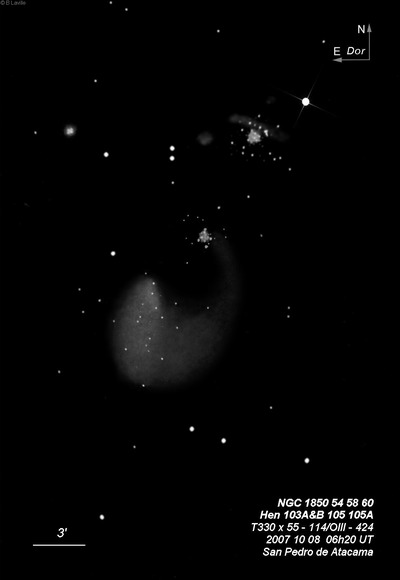
NGC 1850 lies in a very impressive region of the LMC (near the outskirts of the central bar) with 13 additional NGC clusters/nebulosity within 30' including NGC 1854 7' SE, NGC 1858 10' SE, NGC 1856 22' SSE and several others including NGC 1836, 1839, 1847, 1860, 1863, 1865. Unfortunately dawn was starting to break so I only was able to view the first group of objects mentioned above and I need to return to this field!
James Dunlop discovered NGC 1850 = D 172 = h2780 on 3 Aug 1826 and described a "pretty bright round nebula, 40" diameter. This is the preceding and brightest of three nebulae in a line." His position was 10' too far east but correct in declination. The other two "nebulae" are NGC 1855 and 1858. D 170 may be a duplicate observation ("a pretty large faint nebula, irregular figure.")
John Herschel observed this cluster on 6 sweeps beginning on 2 Nov 1834 when he logged "pretty bright, small, round, a cluster of stars 12th mag; diam 1'." The 2nd sweep was recorded as "globular, very bright, very much compressed, 3' diameter." On the third sweep he noted "globular, a fine large clusgter st = 13m, mbM." Herschel gave possible synonyms with D 172 as well as D 170.
400/500mm - 18" (7/10/05 - Magellan Observatory, Australia): After the Tarantula region (30 Doradus complex), NGC 1850 is the brightest star cluster in the LMC and at an estimated age of only 40-50 million years, this rich, globular-like cluster has no counterpart in the Milky Way! At 128x, the cluster appeared very bright (9th magnitude), large, round, ~3.5' diameter, well concentrated with an intensely bright 1' core. A brighter mag 13 star is superimposed on the western side of the halo. Several very faint stars are resolved in the very lively halo.
600/800mm - 24" (4/5/08 - Magellan Observatory, Australia): at 350x in the 24" I was stunned by the view of this huge, extremely bright, blue globular cluster! The outer halo, which extends 5' in diameter, was resolved into dozens of faint stars arranged in irregular star chains that appear to stream out of the core. A single brighter mag 13 star is superimposed on the west side [30" W of center is the core of companion cluster NGC 1850A]. The center is highly concentrated with an extremely bright 1' core that appears elongated, irregular and clumpy with a curved outline. A small, 20" diffuse glow is embedded at the north edge of the halo (open cluster S-L 260).
NGC 1850 resides in a glorious LMC region that is packed with an unbelievable number of clusters and HII regions including NGC 1854 6' SE and NGC 1858, a huge cluster and nebulosity, ~10' SE. A faint loop of nebulosity (LMC-N103A) is involved with the cluster, extending ~N-S on the east end, but I didn't try a filter to see if it was visible.
Notes by Steve Gottlieb